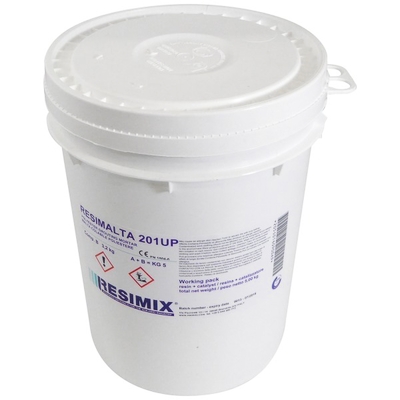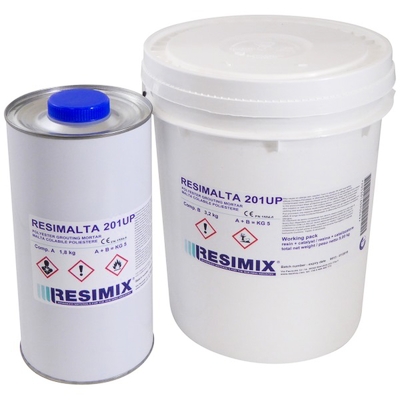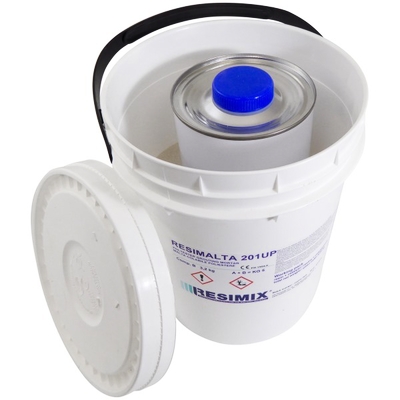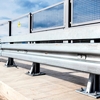RESIMALTA 201 UP
FAST CASTABLE POLYESTER MORTAR FOR HOLDERS AND GROUTING
Fast-setting, high strength polyester resin-based pourable mortar, for bedding anchor bolts in concrete.
Thanks to its fluid composition, RESIMALTA 201 UP can be directly applied to the support without the need for a primer; furthermore, it perfectly fills the castable volume and ensures excellent sealing.
It resists well both to static and dynamic stress and its physical characteristics remain the same throughout the thickness of the cast thanks to a composition which prevents settling of inerts.
RESIMALTA 201 UP also ensures:
- Waterproofing features;
- Fast hardening;
- Excellent adherence to concrete, metal, stone, wood;
- Electric insulation;
- Ease of use: it is packaged in two pre-weighed components to avoid the possibility of mistakes whenweighing.
| Technical characteristics | U.M. | |||||||||||||
|---|---|---|---|---|---|---|---|---|---|---|---|---|---|---|
| Compression strength | 90 | N/mm2 | ||||||||||||
| Bending strength | 15 | N/mm2 | ||||||||||||
| Ultimate elongation | 1,09 | % | ||||||||||||
| Elastic modulus (compression) | 10900 | N/mm2 | ||||||||||||
| Resistance to tear on concrete | > 4 | N/mm2 | ||||||||||||
| Electric resistivity ρ | 1012 | Ω | ||||||||||||
| Viscosity | 10500 | cP | ||||||||||||
| Density of non-hardened mortar | 1,60 | Kg/dm3 | ||||||||||||
| Density of hardened mortar at 25°C | 1,75 | Kg/dm3 | ||||||||||||
| A + B mixture ratio | 100 + 177 |
Tensile strength
The test use a class > C20/25 concrete and have been carried out using class 4.8 threaded rods. RESIMALTA 201 UP is introduced in holes created through revolving percussion and with diameter and depth depending on the size of the threaded rod:
| ø rods (mm) | 8 | 12 | 16 | 20 | 24 | |||||||||
| ø hole (mm) | 12 | 16 | 20 | 25 | 28 | |||||||||
| Hole depth (mm) | 80 | 120 | 160 | 200 | 240 |
Tensile strength of a holder made with RESIMALTA 201 UP in the above conditions is roughly based on the following relation (ø represents the hole diameter, h the hole depth):
Ultimate pull-out strength [kN] = 0.030 x ø [mm] x h [mm]
Preparation of the basement
The surface or hole to be treated must be clean, healthy, dry and mortar grout and crumbly part-free. For best adhesion concrete surfaces must be rough and the metal must be sandblasted to SA 2.5 degree: in case of threaded galvanized rods or enhanced adherence, degreasing is sufficient.
In case of under plate casting or where it is necessary, use a funnel or prepare a suitable formwork with feeding hopper and exit breather pipe. To prevent the mortar from adhering to the formwork, apply a detaching agent or a polyethylene foil.
Holes to fix rods must be made with revolving percussion drill and not through coring; they must then be de-dusted, dried and cleaned.
In case of temperatures below +10°C, remove any possible humidity using compressed air and heat the support for a few minutes using a gas blowpipe, otherwise do not apply.
Preparation and application of the product
The two components must be pre-dosed as per stoichiometric ratio.
Pour component B into component A and blend at slow speed for 3’ – 4’ using drill with helix/spiral to reduce air inlet as much as possible; during this operation, scrape also the bottom and the sides of the bucket.
Application
Cast the mortar in the volume to be filled.
Notes
With low temperatures, keep the product at 20 – 25°C for a few hours before application to foster blending and casting.
Packages are weight pre-measured out: fully use all components A and B. If you wish to divide the package, products must be weighed by respecting the A+B ratio on the label and must not be weighed out based on the volume.
By pouring B component into A component, the hardening reaction starts: following mixture the time available is limited and it depends on the temperature.
| TEMPERATURE | Pot Life | Clamping at 120 Nm | Clamping at 400 Nm | |||||||||||
|---|---|---|---|---|---|---|---|---|---|---|---|---|---|---|
| 5 °C | 120' | 150' | 180' | |||||||||||
| 10 °C | 70' | 90' | 100' | |||||||||||
| 20 °C | 30' | 45' | 55' | |||||||||||
| 30 °C | 20' | 35' | 45' |
The data in the table above refers to an M20 threaded rod in which a bolt is screwed in with driving torque of at least 120 Nm and then of 400 Nm; the same times are valid also in case of rods with different diameter.
The temperature of the product is equal to that in which it has been kept for the past 3 hours.
The support temperature is generally lower than the air temperature during the winter season and higher in the summer season.
At 20 °C complete hardening occurs after 24 hours.
Calculate 1.6 kg/dm3 , specific weight of non-hardened product plus 10% scrap for each hole.
| ø rod [mm] | 8 | 12 | 16 | 20 | 24 | |||||||||
| ø hole [mm] | 12 | 16 | 20 | 25 | 28 | |||||||||
| Hole depth [mm] | 80 | 120 | 160 | 200 | 240 | |||||||||
| no. holes/package | 500 | 250 | 150 | 100 | 70 |
Available in 5 kg packages (A + B component).
If stored in its original and sealed package, the products remains unaltered for a year if kept in environments with a temperature between 10 and 30 °C.
It is suitable for works carried out at low temperatures and it is used for:
- Casts under support plates of bridges, pillars, supports, footings and road joints;
- Holder and injections below rail-tracks of cranes, trolleys and precision machinery;
- Fast restoration of concrete floors and chipped joints;
- Fixing of runway lighting in airports;
- Concrete fast grouting of iron rods, stay wires, railings, poles;
- Reconstruction or new laying through casting of concrete prefab elements (ledges, chippedsupports)
- Plugging through clogging of holes to fix water pipes and tubes;
- Filling and fast hardening of groves and breakings to place technical plants;







